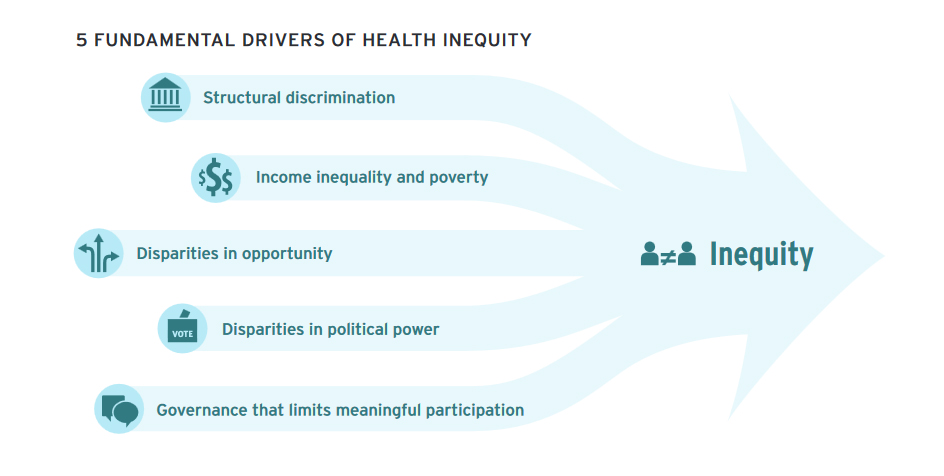Share On Social!
Health equity is when everyone has a fair and just opportunity to live their healthiest life possible.
Yet health inequity remains.
Latinos, for example, face discriminatory policies and barriers to healthcare, social support, healthy food, and more.
That’s why we’re proud to share A Blueprint for Changemakers: Achieving Health Equity Through Law & Policy, a new report from ChangeLab Solutions and the Robert Wood Johnson Foundation that can help communities advance a local agenda to ensure health equity for everyone.
The Blueprint report offers key policies and legal strategies on five underlying realities behind health inequity:
1. Reduce Structural Discrimination
Historic oppression, segregation, and bias create health inequity.
Among Latinos, implicit bias impacts the doctor’s office, police traffic stops, and even the hiring process.

ChangeLab’s Blueprint report suggests these (and other) local actions:
- Enact land-use or affordable housing finance regulations.
- Teach equity through school policies and curricula to confront negative stereotypes.
- Reduce institutional discrimination by requiring an equity analysis or staff training on cultural sensitivity.
2. Reduce Poverty and Disparities in Income and Wealth Accumulation
Latinos suffer high poverty rates. They also suffer wealth gaps and income inequity.

The Blueprint report suggests these (and other) local actions:
- Preserve, protect, and expand social protections by providing supplemental income to support healthy living (i.e., the SNAP program or housing subsidies).
- Improve wages for poor and low-income individuals.
- Reduce the cost of housing, education, transportation, and health care by preserving, protecting, and expanding affordable housing; subsidizing preschool and college for kids from low-income families; expanding public transit; and subsidizing health insurance.
Paid family leave also can reduce use of public services and help families succeed.
3. Reduce Disparities in Opportunity
Early childhood learning affects lifelong social, health, and economic outcomes.

Yet only 40% of U.S. Latinos and 41% of low-income kids participate in preschool programs. That’s compared to 53% of whites and 61% of more affluent kids, according to the Salud America! Research Review.
These kids are at risk of not getting the proper care, services, and environment they need for academic and lifelong success. They risk falling behind in school, missing class, dropping out of high school, engaging in risky behaviors, and suffering from chronic disease.
ChangeLab’s Blueprint report suggests these (and other) local actions:
- Providing universal high-quality preschool education that focuses on child development.
- Improve the primary school learning experience in low-income neighborhoods and addressing barriers to enrolling and staying in school for poor children and children of color.
- Improve access to safe, secure, fairly paid work and year-round work for low-income families. This can be done through direct job creation, apprenticeship programs for those with barriers to employment, or fair-chance hiring for job seekers with criminal records.
4. Reduce Disparities in Power
Only 24% of Latinos feel their community is “extremely” or “very” represented by politicians/people in government, according to a recent study.

The Blueprint report suggests these (and other) local actions:
- Lift up all residents’ voices by using community-based participatory research, inclusive and representative community engagement, participatory budgeting, or public deliberation.
- Build a movement by creating a broad coalition of changemakers to work for health equity policy change.
5. Leverage Governance to Promote Health Equity
Undoing our nation’s legacy of discrimination and segregation through law and policy requires health-equity-focused laws, policies, and government protocols, according to the Blueprint report.
The report suggests these (and other) local actions:
- Establish health equity as a goal of all local planning, budgeting, and government decision-making through by formally committing via a resolution, health promotion plan, or comprehensive plan.
- Strive for effective, responsive, and sustainable action by revising policies, protocols, and practices in ways that both respond to immediate community needs and use resources efficiently so that investments and assets are maintained for future generations.
For example, here are four big tools to help governors understand what influences health equity and how to embed upstream health- and prevention-related plans into the structure of government.
How Else Can You Promote Health Equity?
The ChangeLab Blueprint report is a valuable resource for people who have seen what inequality looks like and are ready for a new approach that gives everyone a fair chance to live a healthy life.
Changemakers can explore the full report.
Then you can use the report’s principles to ensure that local laws and policies lead to equitable outcomes:
- Engage community members.
- Built the capacity of communities.
- Understand the roots of local problems.
- Align action to solve core community problems.
You can make a difference for health equity—even if you aren’t in an elected office.
Parents and residents play a big role in helping leaders make change. These individuals can join neighborhood associations and local committees, boards, and commissions. These groups rely on your input to shape plans and policies that impact health in your area.
By The Numbers
23.7
percent
of Latino children are living in poverty



